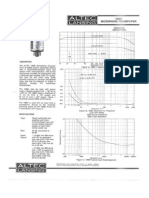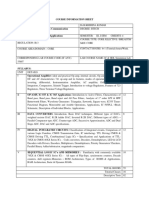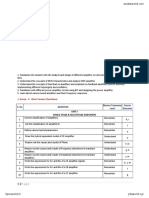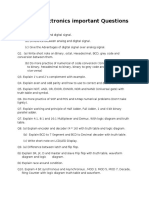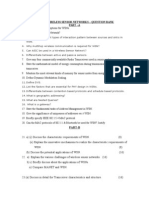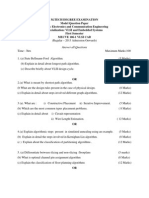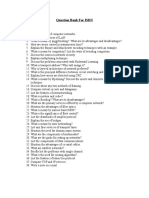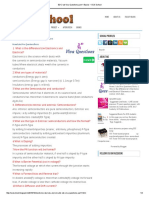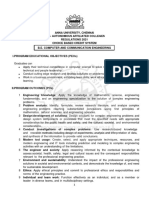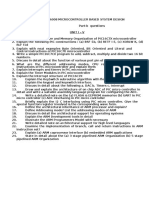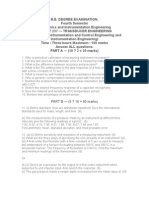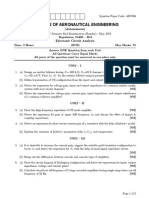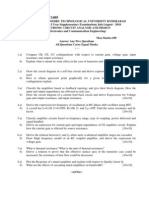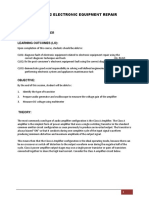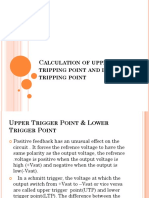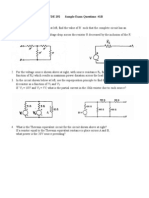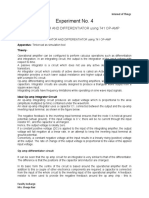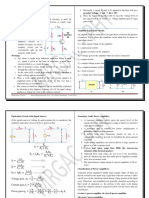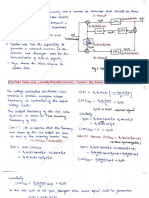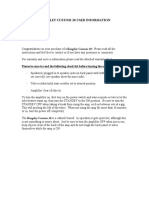Electronic Circuit Analysis
Electronic Circuit Analysis
Uploaded by
Ishansi AgrawalOriginal Description:
Original Title
Copyright
Available Formats
Share this document
Did you find this document useful?
Is this content inappropriate?
Report this DocumentCopyright:
Available Formats
Electronic Circuit Analysis
Electronic Circuit Analysis
Uploaded by
Ishansi AgrawalCopyright:
Available Formats
QUESTION BANK 2019
SIDDHARTH GROUP OF INSTITUTIONS :: PUTTUR
Siddharth Nagar, Narayanavanam Road – 517583
QUESTION BANK (DESCRIPTIVE)
Subject with Code : Electronic Circuit Analysis (16EC407) Course & Branch: B.Tech - ECE
Year & Sem: II-B.Tech & II-Sem Regulation: R16
UNIT –I
SMALL SIGNAL LOW FREQUENCY TRANSISTOR AMPLIFIER ANALYSIS
1. a) Why hybrid model is used for the analysis of BJT amplifier at low frequencies? Draw the
hybrid model for CE transistor and derive the parameters. [6M]
b) Compare the CE, CB and CC transistor amplifier parameters. [6M]
2. Using low frequency h-parameter model, derive the expressions for voltage gain, current gain,
input impedance and output admittance for a BJT Amplifier in CE configuration. [12M]
3. a) With neat diagram, derive the CE amplifier parameters using approximate analysis. [6M]
b) Obtain the expressions for current gain, voltage gain, input impedance and output impedance
of CB amplifier using simplified hybrid model. [6M]
4. a) Determine the parameters Ai, Ri, Av and R0 of Emitter Follower using simplified hybrid model
analysis. [6M]
b) A voltage source of internal resistance Rs = 900Ω drives a CC amplifier using load resistance
RL=2000Ω. The CE h parameters are hfe=60, hie=1200Ω, hoe = 25µA/V and hre = 2 x 10-4.
Compute Ai, Ri, Av and R0 using approximate analysis. [6M]
5. A CE amplifier is driven by a voltage source of internal resistance Rs = 800Ω and the load
impedance of RL=1000Ω. The h-parameters are hie=1k, hfe=50, hoe = 25µA/V and hre = 2 x 10-4.
Calculate current gain, voltage gain, input impedance and output impedance using exact
analysis and approximate analysis. [12M]
6. Consider a single stage CE amplifier with Rs = 1kΩ, R1 = 50kΩ, R2 = 2kΩ, Rc = 1kΩ, RL =
1.2kΩ, hfe=50, hie=1.1k, hoe = 25µA/V and hre = 2.5 x 10-4, as shown in Fig. Find Ai, Ri, Av, Avs,
AIS and R0. [12M]
Electronic Circuit Analysis Page 1
QUESTION BANK 2019
7. a) Obtain the expression for current gain, voltage gain, input impedance and output impedance
For Common Emitter Amplifier with Emitter Resistor. [6M]
b) A CE amplifier is driven by a voltage source of internal resistance Rs = 1000Ω and the
load impedance of RC=2kΩ. The h-parameters are hie=1.3k, hfe=55, hoe = 22µA/V and
hre = 2 x10-4. Neglecting biasing resistors, compute current gain, voltage gain, input
impedance, output impedance for the value of Emitter Resistor RE = 200Ω inserted in the
emitter circuit. [6M]
8. a) Draw the circuit diagram of a single stage RC coupled Amplifier and discuss the steps used
for designing it. [6M]
b) Determine Voltage Gain, Current Gain, Input resistance and Output resistance for a CE
amplifier using NPN transistor with hie = 1200Ω, hre = 0, hfe = 36 and hoe = 2 x 10-6 mhos,
RL = 2.5kΩ and RS = 500Ω (neglect the effect of biasing circuit). [6M]
9. Design a single stage RC coupled BJT amplifier for the following values. Assume that for
Silicon transistor, Vcc = 10V, Ic = 4mA, hfe = 100, hie = 1kΩ, RL = 100kΩ and fL = 100Hz. [12M]
10. a) Draw the circuit diagram of JFET Common Source amplifier with voltage divider bias for
bypassed Rs and determine the expression for input impedance, output impedance and
voltage gain. [6M]
b) Derive input impedance, output impedance and voltage gain of JFET Common Drain
amplifier with neat diagram. [6M]
Electronic Circuit Analysis Page 2
QUESTION BANK 2019
UNIT –II
SMALL SIGNAL HIGH FREQUENCY TRANSISTOR AMPLIFIER ANALYSIS
1. a) Draw the Hybrid-pi model and explain the significance of each and every component in it. [6M]
b) Derive the expression for Hybrid- π capacitance of CE transistor at high frequency. [6M]
2. Derive the expressions for the hybrid π parameters gm, gb’e, gb’c, rbb’ and gce. [12M]
3. a) Mention the typical values of Hybrid- π parameters. [6M]
b) A BJT gm = 38mƱ, rb’e = 5.9kΩ, hie = 6kΩ, rbb’ = 100Ω, Cb’c = 12pF, Cb’e = 63pF and hfe =
224 at 1 kHz. Calculate fα, fβ and fT cutoff frequencies. [6M]
4. With the help of necessary circuit diagrams and approximations obtain the expression for CE
Short circuit current gain and derive the relation between fβ and fT. [12M]
5. a) Discuss the dependency of hybrid-pi parameters upon collector current, VCE and Temperature. [6M]
b) A BJT has the following parameters measured at Ic=1mA, hie=3kΩ, hfe=100, Cc=2pF
and Ce=18pF. Find gm, rb’e, and rbb’ for RL=1 KΩ. [6M]
6. a) At Ic = 1mA and VCE=10V, a certain transistor data shows Cc = Cb’c = 3pF, hfe = 200 and
wT = -500 M rad/sec. Calculate gm, rb’e, Ce = Cb’e and wβ. [10M]
b) Define Unity Gain Frequency fT. [2M]
7. Obtain the expression for Current gain with load resistor and explain the variation of frequency
Response with RL. [12M]
8. a) Short circuit CE current gain of a transistor is 25 at a frequency of 2MHz. If fβ = 200KHz
Calculate (i) fT (ii) hfe (iii) Find |Ai| at frequency of 10MHz and 100MHz. [6M]
b) Derive the expression for cut off frequencies fα, fβ and fT. [6M]
9. a) Describe the relationship between low frequency h-parameters and high frequency
Parameters. [8M]
b) Write about Collector junction capacitance and Emitter junction capacitance of
hybrid-pi model. [4M]
10. A transistor has hie = 6kΩ and hfe = 224 at IC = 1mA, with fT = 80MHz and Cb’c = 12pF.
Determine gm, rb’e, rbb’ and Cb’e at room temperature. [12M]
Electronic Circuit Analysis Page 3
QUESTION BANK 2019
UNIT –III
MULTISTAGE AMPLIFIERS
1. (a) Explain the classification of amplifiers. [6M]
(b) Discuss the need of cascading amplifiers. [6M]
2. Describe different methods used for coupling multistage amplifiers with their frequency
response. [12M]
3. Draw the block diagram of n-stage cascaded amplifier and analyze its various parameters. [12M]
4. Analyze Two stage RC coupled amplifier with neat diagrams. [12M]
5. With neat diagram explain cascode amplifier and derive the overall voltage gain of cascode
amplifier. [12M]
6. a) What is Darlington Connection? Mention the advantages of Darlington Pair Amplifier.[4M]
b) With diagram, derive the expression for current gain and input resistance of Darlington
amplifier. [8M]
7. Explain how the input impedance is increased by Bootstrap Emitter Follower with neat
diagram. [12M]
8. a) Explain the effect of cascading of amplifiers on bandwidth. [6M]
b) An amplifier consists of 3 identical stages in cascade, the bandwidth of overall amplifier
extends from 20 Hz to 20 kHz. Calculate the bandwidth of individual stage. [6M]
9. The following figure shows CE-CE cascade amplifier with their biasing arrangements.
Calculate Ri, Ai, Av, Ri’, Avs and Ais if circuit parameters are: Rs=1K, Rc1 = 15K, RE1= 100Ω,
RC2 = 4 KΩ, RE2 = 330Ω with R1 = 200K and R2 = 20K for first stage and R1 = 47K and R2 =
4.7K for second stage. Assume that hie = 1.2kΩ, hfe = 50, hre = 2.5 x 10-4 and hoe = 25 x 10-6
A/V. [12M]
Electronic Circuit Analysis Page 4
QUESTION BANK 2019
10. For the circuit shown in Fig. Calculate Ri, Ai, AV and Ro. hie=1.1k, hfe=50, hoe = 25µA/V and
hre = 2.5 x 10-4. [12M]
UNIT –IV
FEEDBACK AMPLIFIERS AND OSCILLATORS
1. Explain the characteristics of negative feedback amplifiers. [12M]
2. a) Discuss Feedback topologies. [6M]
b) An amplifier has an open loop gain of 1000 and a feedback ratio of 0.04. If the open loop
gain changes by 10% due to temperature, find the percentage change in gain of the amplifier
with feedback. [6M]
3. a) Derive the expressions of input and output resistances for Voltage Series FBA. [6M]
b) Determine the input and output resistances of Current Shunt feedback amplifier. [6M]
4. a) Derive the expressions of input and output resistances for Voltage Shunt FBA. [6M]
b) Determine the input and output resistances of Current Series feedback amplifier. [6M]
5. a) An amplifier has a voltage gain of 400, f1 = 50 Hz, f2 = 200kHz and a distortion of 10%
without feedback. Determine the amplifier voltage gain, f1f, f2f and Df when a negative
feedback is applied with feedback ratio of 0.01. [6M]
b) A voltage series negative feedback amplifier has a voltage gain without feedback of A = 500,
input resistance Ri = 3kΩ, output resistance R0 = 20kΩ and feedback ratio β = 0.01. Calculate
the voltage gain Af, input resistance Rif, and output resistance Rof of the amplifier with
feedback. [6M]
6. a) State Barkhausen Criterion for oscillations. Explain the principle of operation of
oscillator. [6M]
b) Classify the different types of oscillators. [6M]
Electronic Circuit Analysis Page 5
QUESTION BANK 2019
7. a) Derive the expression for frequency of oscillations for RC phase shift Oscillator. [6M]
b) Discuss the working principle of Wein bridge oscillator and derive the expression for
frequency of oscillations. [6M]
8. a) With neat diagram, explain Hartley Oscillator and derive the expression for frequency of
oscillation. [6M]
b) Discuss Colpitts Oscillator and obtain the expression for frequency of oscillation. [6M]
9. a) Give the general analysis of an LC Oscillator. [6M]
b) Draw the equivalent circuit of a Quartz Crystal and explain its principle of operation with the
help of neat circuit diagram. [6M]
10. a) Explain the concept of stability of Oscillators. [6M]
b) In the Hartley oscillator, L2 = 0.4mH and C = 0.004 µF. If the frequency of the oscillator is
120 kHz, find the value of L1. Neglect the mutual inductance. [6M]
UNIT V
POWER AMPLIFIERS & TUNED AMPLIFIERS
1. a) With neat diagram explain Series fed, Directly coupled Class A Power Amplifier and derive
its maximum efficiency. [6M]
b) A series fed Class A amplifier shown if the Fig, operates from dc source and applied
sinusoidal input signal generates peak base current 9mA. Calculate : (i) Quiescent current
ICQ, (ii) Quiescent voltage VCEQ, (iii) DC input power PDC, (iv) AC output power PAC and
(v) Efficiency. [6M]
2. a) Discuss with diagram, Transformer coupled Class A Power Amplifier and derive its
Maximum efficiency. [6M]
b) Explain second harmonic distortion by three point method. [6M]
3. a) Describe Higher order harmonic distortion by five point method. [6M]
b) With neat diagram explain Push Pull Class B Power Amplifier and derive its maximum
Electronic Circuit Analysis Page 6
QUESTION BANK 2019
efficiency. [6M]
4. a) Describe Complementary Symmetry Class B Power Amplifier with diagram and write about
crossover distortion in class B power amplifiers. [6M]
b) A class B push pull amplifier supplies power to a resistive load of 12Ω. The output
transformer has a turns ratio of 3:1 and efficiency of 78.5%. Obtain (i) Maximum power
output, (ii) maximum power dissipation in each transistor and (iii) Maximum base and
collector current. For each transistor, assume hfe = 25 and VCC = 20V. [6M]
5. a) Write notes on Class AB operation. [6M]
b) Discuss the need of Heat sink for power transistors. Mention about thermal stability of power
transistors. [6M]
6. a) Compare Single Tuned and Double Tuned Amplifier. [2M]
b) Describe the operation of a single tuned capacitive coupled amplifier with diagram and
derive the expression for its centre frequency, Quality factor, Voltage gain and bandwidth. [12M]
7. Discuss Double Tuned Amplifier with neat diagram and derive the expression for its
bandwidth. [12M]
8. a) Explain the effect of cascading single tuned amplifiers on bandwidth. [6M]
b) The bandwidth of single tuned amplifier is 20kHz. Calculate the bandwidth if such three
stages are cascaded. Also calculate the bandwidth for four stages. [6M]
9. a) With circuit diagram, explain the stagger tuning operation. Give necessary graph. [6M]
b) Explain the stability considerations of a tuned amplifier. [6M]
10. a) A single tuned RF amplifier uses a transistor with an output resistance of 50 KΩ, output
capacitance of 15 pF and internal resistance of next stage is 20 kΩ. The tuned circuit consists
of 47 pF capacitance in parallel with series combination of 1µH inductance and 2Ω resistance.
Calculate resonant frequency, effective quality factor and bandwidth of the circuit. [6M]
b) Explain the advantages, disadvantages and applications of Tuned Amplifiers. [6M]
Prepared by:
1. Dr. P.RATNA KAMALA
Professor/ECE
2. Mr M. AFSAR ALI
Professor/ECE
Electronic Circuit Analysis Page 7
You might also like
- Altec 1588C DatasheetDocument2 pagesAltec 1588C DatasheetBrandon ParsonsNo ratings yet
- Eca Chapter Wise QuestionsDocument7 pagesEca Chapter Wise QuestionsDinesh PalavalasaNo ratings yet
- M.E Advanced Radiation Systems Question PaperDocument2 pagesM.E Advanced Radiation Systems Question PaperArun ShanmugamNo ratings yet
- Awp Unit Wise QuesDocument5 pagesAwp Unit Wise QuesNagireddy GujjulaNo ratings yet
- Model Question Paper Engineering Electromagnetics (Em) - 1Document3 pagesModel Question Paper Engineering Electromagnetics (Em) - 1Rahul ThumarNo ratings yet
- EC8701 Antennas and Microwave EngineeringDocument42 pagesEC8701 Antennas and Microwave Engineeringthirsh ragavNo ratings yet
- 5 Years Anna University Question PaperDocument13 pages5 Years Anna University Question PaperG. SIVARANJANI Associate ProfessorNo ratings yet
- Ldica Course Info Sheet and Question BankDocument28 pagesLdica Course Info Sheet and Question BankDr.B.Krishna KumarNo ratings yet
- Question Paper Code:: (10×2 20 Marks)Document3 pagesQuestion Paper Code:: (10×2 20 Marks)krithikgokul selvam100% (1)
- Group - A (Short Answer Questions) : S. No Blooms Taxonomy Level Course OutcomeDocument14 pagesGroup - A (Short Answer Questions) : S. No Blooms Taxonomy Level Course OutcomeDr. Shafiulla Basha Shaik100% (1)
- PE&I questionbankIIIsemDocument2 pagesPE&I questionbankIIIsemSavita SomaNo ratings yet
- Digital Electronics Important QuestionsDocument2 pagesDigital Electronics Important QuestionsDildar Khan BhatiNo ratings yet
- Ec2051 QBDocument3 pagesEc2051 QBBalajee Kowshik0% (1)
- Experiment No. 5 Darlington Pair Connection: (CITATION Ele /L 1033)Document4 pagesExperiment No. 5 Darlington Pair Connection: (CITATION Ele /L 1033)Dan BautistaNo ratings yet
- 2823-CL7003-Wireless Sensor NetworksDocument5 pages2823-CL7003-Wireless Sensor Networkseshwari369No ratings yet
- Ec 3501 Wirelss Communication Lab ManualDocument34 pagesEc 3501 Wirelss Communication Lab ManualperiyasamyNo ratings yet
- CMC - Important QuestionsDocument4 pagesCMC - Important QuestionsVenkatesh Patnala SoniNo ratings yet
- Question Bank: Site&q WirelessDocument4 pagesQuestion Bank: Site&q WirelessSanjana AkkoleNo ratings yet
- Analysis and Design of Analog IcDocument21 pagesAnalysis and Design of Analog Icshankar100% (1)
- VLSI CAD QuestionDocument2 pagesVLSI CAD QuestionMCV101No ratings yet
- EMI/EMC Question PaperDocument2 pagesEMI/EMC Question PaperNaresh KumarNo ratings yet
- Model Exam Ocn 3Document2 pagesModel Exam Ocn 3Prabu KumarNo ratings yet
- Model QP - MPMC Lab - Wo Split UpDocument3 pagesModel QP - MPMC Lab - Wo Split Upsujaganesan20090% (1)
- ISDN Question BankDocument3 pagesISDN Question Bankmaithuong85No ratings yet
- Ec 8261 - Circuits and Devices Laboratory: Second SemesterDocument5 pagesEc 8261 - Circuits and Devices Laboratory: Second SemesterSamraj JebasinghNo ratings yet
- CU5301-Millimeter Wave CommunicationsDocument12 pagesCU5301-Millimeter Wave CommunicationsVaralakshmi D TeachingNo ratings yet
- Ec8762 Dip Lab ManualDocument55 pagesEc8762 Dip Lab ManualSridharan D100% (1)
- 2.4 Operating Systems and Execution EnvironmentsDocument12 pages2.4 Operating Systems and Execution EnvironmentssaravananNo ratings yet
- Edc Viva QuestionsDocument12 pagesEdc Viva Questionsitchai uchia100% (1)
- DCN-unit-1 ModifiedDocument112 pagesDCN-unit-1 ModifiedMayank KumarNo ratings yet
- EE3402 Linear Integrated Circuits Reg 2021 Notes (Unit I)Document20 pagesEE3402 Linear Integrated Circuits Reg 2021 Notes (Unit I)Monika GNo ratings yet
- Viva Questions For Advanced Communication LabDocument6 pagesViva Questions For Advanced Communication LabMohan Kumar K S60% (5)
- DSP Question Paper Unit 4Document2 pagesDSP Question Paper Unit 4shankarNo ratings yet
- Subject Title: Analog Circuits: 18EC42 Model Question Paper-1 With Effect From 2019-20 (CBCS Scheme)Document3 pagesSubject Title: Analog Circuits: 18EC42 Model Question Paper-1 With Effect From 2019-20 (CBCS Scheme)VijaykumarPatilNo ratings yet
- Spin ProtocolsDocument25 pagesSpin Protocolsme_uniqueNo ratings yet
- Analog & Digital VLSI Design Practice QuestionsDocument24 pagesAnalog & Digital VLSI Design Practice QuestionsAbhinav MishraNo ratings yet
- Anna University, Chennai Non-Autonomous Affiliated Colleges Regulations 2021 Choice Based Credit System B.E. Computer and Communication EngineeringDocument42 pagesAnna University, Chennai Non-Autonomous Affiliated Colleges Regulations 2021 Choice Based Credit System B.E. Computer and Communication EngineeringSuganthiVasanNo ratings yet
- JNTUK-M Tech-2018-1st Semester-Feb-R17 R16 R15 R13-G6803022018 CMOS ANALOG IC PDFDocument1 pageJNTUK-M Tech-2018-1st Semester-Feb-R17 R16 R15 R13-G6803022018 CMOS ANALOG IC PDFRanjith DevulapalliNo ratings yet
- EC8562 - Wireless Communication Unit - Iv DiversityDocument22 pagesEC8562 - Wireless Communication Unit - Iv DiversitySudha GaneshNo ratings yet
- JNTUA Digital Signal Processing Notes - R20Document88 pagesJNTUA Digital Signal Processing Notes - R20durgatathaNo ratings yet
- AWP (2 Marks Question and Answers-Converted-WatermarkDocument43 pagesAWP (2 Marks Question and Answers-Converted-WatermarkRahman Abdul86% (7)
- Module2 NotesDocument35 pagesModule2 Notessaralas.rvitmNo ratings yet
- STLD Previous PapersDocument24 pagesSTLD Previous PapersRaju Vericherla100% (1)
- Ldica Objective..Unit WiseDocument5 pagesLdica Objective..Unit WiseRAJOLI GIRISAI MADHAVNo ratings yet
- EE6008 MBSD QBL Important QuestionsDocument1 pageEE6008 MBSD QBL Important QuestionshelenseelanNo ratings yet
- Running Machines: Arm Multiple ChoiceDocument4 pagesRunning Machines: Arm Multiple ChoicePoojaNo ratings yet
- Electronic Devices Model Question PapersDocument2 pagesElectronic Devices Model Question Papersk_kunarajNo ratings yet
- To Study The Outage Probability, LCR & ADF in SISO For Selection Combining and MRC.Document9 pagesTo Study The Outage Probability, LCR & ADF in SISO For Selection Combining and MRC.GaneshNo ratings yet
- 2 MarksDocument30 pages2 MarksAnitha Kumari SivathanuNo ratings yet
- Ee 2254 Linear Integrated Circuits and Applications Anna University Previous Year Question PaperDocument2 pagesEe 2254 Linear Integrated Circuits and Applications Anna University Previous Year Question Paperkibrom atsbhaNo ratings yet
- Radar Systems Imp QuestionsDocument3 pagesRadar Systems Imp QuestionsDivya Hirekar100% (1)
- 8085 Microprocessor 2 Mark QuestionsDocument1 page8085 Microprocessor 2 Mark QuestionsJineshNo ratings yet
- 1252-Transducer Engineering Question PaperDocument5 pages1252-Transducer Engineering Question Papermoney_kandan2004100% (1)
- Unit - 2 Sensor Networks - Introduction & ArchitecturesDocument32 pagesUnit - 2 Sensor Networks - Introduction & Architecturesmurlak37No ratings yet
- 4.block Diagram of Internal PacemakerDocument3 pages4.block Diagram of Internal Pacemakersastry garuNo ratings yet
- Course FileDocument254 pagesCourse FileBasheer NajemNo ratings yet
- Rfic Question BankDocument25 pagesRfic Question BankJenny ThanushawNo ratings yet
- Institute of Aeronautical Engineering: (Autonomous) Electronic Circuit AnalysisDocument2 pagesInstitute of Aeronautical Engineering: (Autonomous) Electronic Circuit AnalysisNiranjan KashyapNo ratings yet
- C1EC01-C1405 - ELECTRONIC CIRCUIT ANALYSIS & DESIGN MergedDocument18 pagesC1EC01-C1405 - ELECTRONIC CIRCUIT ANALYSIS & DESIGN Mergedchini_naniNo ratings yet
- Electronic Circuit Analysis July 2023Document8 pagesElectronic Circuit Analysis July 2023raj3roy4No ratings yet
- Institute of Aeronautical Engineering: (Autonomous)Document4 pagesInstitute of Aeronautical Engineering: (Autonomous)VigneshNo ratings yet
- Shiv Jyoti Educational Group: Class-XII (RBSE) Subject - Biology Chapter - 21 Integumentary System in HumanDocument3 pagesShiv Jyoti Educational Group: Class-XII (RBSE) Subject - Biology Chapter - 21 Integumentary System in HumanIshansi AgrawalNo ratings yet
- Shiv Jyoti Educational Group: Class-XII (RBSE) Subject - Biology Chapter - 14 Biotechnology - General IntroductionDocument3 pagesShiv Jyoti Educational Group: Class-XII (RBSE) Subject - Biology Chapter - 14 Biotechnology - General IntroductionIshansi AgrawalNo ratings yet
- Class-12 (RBSE) Biology-Ch-24 Blood Circulatory System PDFDocument7 pagesClass-12 (RBSE) Biology-Ch-24 Blood Circulatory System PDFIshansi AgrawalNo ratings yet
- Ishansi AgrawalDocument1 pageIshansi AgrawalIshansi AgrawalNo ratings yet
- Practical Work 4Document6 pagesPractical Work 4Muhammad ZakiyNo ratings yet
- Tribhuwan University Institute of Engineering Pulchowk CampusDocument17 pagesTribhuwan University Institute of Engineering Pulchowk CampusAchyut KayasthaNo ratings yet
- UNIT - 1 - FeedbackDocument32 pagesUNIT - 1 - FeedbackGauthiNo ratings yet
- Lab 8 Power Amplifier BBN 10205 (Done)Document5 pagesLab 8 Power Amplifier BBN 10205 (Done)Zhamir ZhakwanNo ratings yet
- Unit 2 - Operational AmplifiersDocument32 pagesUnit 2 - Operational AmplifiersVimala ElumalaiNo ratings yet
- Calculation of Upper and Lower Tripping Point PF Schmitt TrigerDocument6 pagesCalculation of Upper and Lower Tripping Point PF Schmitt TrigerAjay Kumar SinghNo ratings yet
- SYDE 292 Sample Exam Questions #1B QuestionsDocument1 pageSYDE 292 Sample Exam Questions #1B Questionscartoon_nateNo ratings yet
- Lab 4: Introduction To Operational Amplifiers: ObjectiveDocument10 pagesLab 4: Introduction To Operational Amplifiers: Objectivepaul omondi ochiengNo ratings yet
- Experiment No. 4: Integrator and Differentiator Using 741 Op-AmpDocument4 pagesExperiment No. 4: Integrator and Differentiator Using 741 Op-AmpPrasad mohite50% (2)
- Design of Fully Differential Operational Amplifier With High Gain, Large Bandwidth and Large Dynamic RangeDocument93 pagesDesign of Fully Differential Operational Amplifier With High Gain, Large Bandwidth and Large Dynamic RangeAhmed EdrisNo ratings yet
- BBP PDFDocument1 pageBBP PDFjesus fuentesNo ratings yet
- Region 7 - 101 To 180Document95 pagesRegion 7 - 101 To 180Ronald TorresNo ratings yet
- Electronic Circuit Analysis QBDocument14 pagesElectronic Circuit Analysis QBmadhuriNo ratings yet
- Active LoadsDocument9 pagesActive LoadsGowndaManiNo ratings yet
- Amplifiers and OscillatorsDocument10 pagesAmplifiers and OscillatorsKapil ChoudharyNo ratings yet
- Chapter Three System Driver 3.1 MOSFET Control CircuitDocument11 pagesChapter Three System Driver 3.1 MOSFET Control CircuitAlhussain EmbarkNo ratings yet
- Lab Experiment-03 Differentiator and Integrator Amplifiers. 30/07/2020Document6 pagesLab Experiment-03 Differentiator and Integrator Amplifiers. 30/07/2020Mandal AmanNo ratings yet
- Op Amp DifferentiatorDocument11 pagesOp Amp DifferentiatorMuhammad Haroon100% (1)
- Basic Electronics (18ELN14/18ELN24) - Feedback Amplifiers and Oscillators (Module 4)Document14 pagesBasic Electronics (18ELN14/18ELN24) - Feedback Amplifiers and Oscillators (Module 4)Shrishail Bhat100% (1)
- Sound Amplification SystemDocument8 pagesSound Amplification SystemSrushti KitukaleNo ratings yet
- June15 10EE56 PDFDocument2 pagesJune15 10EE56 PDFrama KrishnaNo ratings yet
- Design of Low-Power High-Gain Operational Amplifier For Bio-Medical ApplicationsDocument6 pagesDesign of Low-Power High-Gain Operational Amplifier For Bio-Medical ApplicationsAFSAL ANo ratings yet
- 27 Costas Loop ReceiverDocument3 pages27 Costas Loop Receiverkarthik reddyNo ratings yet
- 05 ECMIXS30 Quiz 02 1Document9 pages05 ECMIXS30 Quiz 02 1Women's Welfare Section MSWDWWSNo ratings yet
- Unit-IV, Cmos Operational AmplifiersDocument45 pagesUnit-IV, Cmos Operational AmplifiersTejaswini KonetiNo ratings yet
- Kingsley Custom 30 User Information: Please Be Sure To Read The Following Check List Before Turning The Amplifier ON!Document5 pagesKingsley Custom 30 User Information: Please Be Sure To Read The Following Check List Before Turning The Amplifier ON!lighetiNo ratings yet
- DBX 586H PreampDocument17 pagesDBX 586H Preampenergicul100% (1)
- CIE 1 LIC Set 2Document2 pagesCIE 1 LIC Set 2menakadevieceNo ratings yet
- Ec3462 Lic Lab ManualDocument62 pagesEc3462 Lic Lab ManualDivya PriyaNo ratings yet
